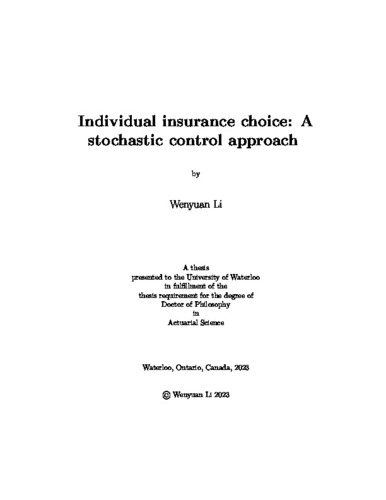| dc.description.abstract | This thesis applies the stochastic control approach to study the optimal insurance strategy for three problems. The first problem studies the optimal non-life insurance for an individual exhibiting internal habit formation in a life-cycle model. We show that the optimal indemnity is deductible under the expected premium principle. Under the additional assumption of exponential utility functions, we obtain the optimal strategies explicitly and find that habit formation reduces insurance coverage. Our model offers a potential explanation for the global underinsurance phenomenon. Some numerical examples and sensitivity analysis are presented to highlight our theoretical results.
The second problem analyzes the optimal defined-contribution (DC) pension management under stochastic interest rates and expected inflation. Besides financial risk, we consider the mortality risk before retirement and introduce life insurance to the pension portfolio. We formulate this pension management problem by a Hamilton-Jacobi-Bellman (HJB) equation, derive its explicit solution, show the explicit solution's global existence, and prove the verification theorem. Our numerical research reveals that the pension member's demand for life insurance exhibits a hump shape with age and a ``double top'' pattern for the real short rates and expected inflation (high demand when the real short rates and expected inflation are both high or both low). These demand patterns are caused by the combined effects of the components in the optimal insurance strategy.
The third problem is constrained portfolio optimization in a generalized life-cycle model. The individual with a stochastic income manages a portfolio consisting of stocks, a bond, and life insurance to maximize his or her consumption level, death benefit, and terminal wealth. Meanwhile, the individual faces a convex-set trading constraint, of which the non-tradeable asset constraint, no short-selling constraint, and no borrowing constraint are special cases. Following Cuoco (1997), we build the artificial markets to derive the dual problem and prove the existence of the original problem. With additional discussions, we extend his uniformly bounded assumption on the interest rate to an almost surely finite expectation condition and enlarge his uniformly bounded assumption on the income process to a bounded expectation condition. Moreover, we propose a dual control neural network approach to compute tight lower and upper bounds for the original problem, which can be utilized in more general cases than the simulation of artificial markets strategies (SAMS) approach in Bick et al. (2013). Finally, we conclude that when considering the trading constraints, the individual will reduce his or her demand for life insurance. | en |

